Pekka Buttler, March 2020 (Updated 2/2022)
Introduction
This article is about the Nikon F lens mount – one of the most long-lived and (arguably) successful lens mounts for single lens reflex (SLR) cameras. The article assumes you know the basics concerning lens mounts (if not, read: An Introduction to Lens Mounts ) and instead focuses mainly on the Nikon F -mount.
The Nikon F mount is characterized by its extraordinary longevity and its ability (coupled with Nikon’s will) to accommodate new functionality while keeping the lens mount’s changes to a minimum, thus enabling extraordinary compatibility, while (sadly) also leading to some quirks. This article therefore also touches upon the modifications made to the mount over the years and discusses their implications.
Nikon F mount specifications
Mount type: Bayonet (lens release on body)
Flange focal distance: 46,5 mm
Film format: 36mm x 24mm (‘Full frame’)
Mount communication: varies based on mount type (pre-Ai/Ai/AF. See details below)
Early history
It all began in 1959…
Nikon (originally Nippon Kōgaku Kōgyō Kabushikigaisha or “Japan Optical Industries Corporation”) had been making other optics since its founding in 1917, and entered the camera lens business in 1932. As with most camera companies in those days, Nikon’s early post-war years were focused on rangefinder cameras and accompanying lenses. These cameras and lenses used the Nikon S-mount (which might one day deserve an article of its own). That all changed in the late 1950’s with the introduction of the Nikon F SLR system camera, with its attending F-mount.
The F-mount largely owes its success to the Nikon F -camera (and its successors) as well as Nikon’s all-in commitment to its line of 35 mm SLR’s and attendant lenses. Within three years of its launch, Nikon had produced a wide range of lenses (more than a dozen), ranging from an 8mm fish-eye to a 1000mm mirror lens, for the Nikon F-mount. Furthermore, the Nikon F was a true system camera, meaning that not only did it have a range of interchangeable lenses, but also a wide array of assorted accessories (such as 250 exposure motorized backs, speedlights etc.). While not directly related to the F-mount, these accessories helped cement the position of the Nikon F camera – especially in the prestigious pro-segment – thus unquestionably contributing to the initial success of the Nikon F-mount.
The Nikon F-mount is a classic bayonet mount with three non-symmetric lugs, meaning that lenses cannot be inserted in more ways than one. You insert the lens into the camera body while aligning identifying features on lens and body, twist the lens counter-clockwise until you hear a click, locking the lens in place. As such, the mount offered a secure attachment which nevertheless was both speedier for the attaching and detaching of lenses than screw/thread mounts, while simultaneously being somewhat more resistant to wear (compared to thread mounts).
While there are few mechanical or design features to distinguish the Nikon F-mount from other contemporary SLR lens mounts, the one thing which nevertheless makes the Nikon F-mount interesting is its longevity. Having seen the light of day in 1959, the lens mount is today (2022) more than 60 years old and while it has seen several modifications and additions through the years, you may still be able to use one of the original F-lenses from 1959 with your brand-spanking new Nikon digital SLR, but with some important caveats. This article is intended to reveal (and explain) those caveats, as well as give a nice case study of how a lens mount can be modified over time to literally make room for novel technologies.
Stage 1: Nikkor F, C and K lenses
As mentioned earlier, Nikon started building the repertoire of Nikon F-lenses in 1959, and these initial lenses are generally referred to as Nikkor F-type lenses. Together with the subsequent C and K -type lenses (which are collectively referred to as non-AI or pre-AI lenses), they share the same body-lens interface and will thus be treated together.
• F-type lenses were the ‘original’ lenses for the Nikon F system. Many (but not all) of them still carry the original “Nippon Kogaku” name.
• C stands for ‘Coating’ and were multicoated lenses.
• K-type lenses were a modernization of a lens’s outward apperance (for the untrained eye, a K type lens looks a lot like a later Ai/AI-s lens, especially if it has been Ai’d)
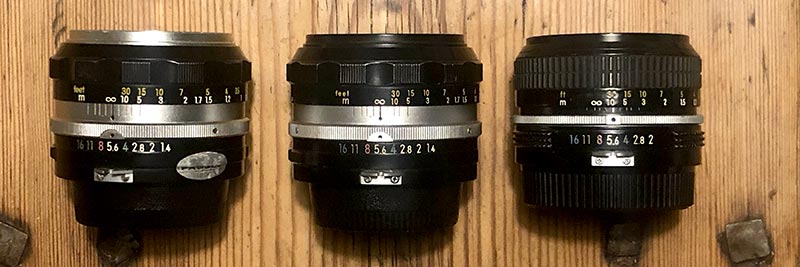
Centre: C-type lens – Scalloped focus ring, one silver ring (Nikkor-S•C 50 mm f/1.4)
Right: K-type lens– rubberised focus ring, all black (Nikkor 50 mm f/2)
All lenses are Pre-Ai.

The original F-type lenses were uncoated or single-coated lenses, and starting in ca. 1970, F-type lenses were gradually replaced by multicoated C-type lenses (C stands for ‘Coating’ or ‘Coated’) while otherwise keeping mostly the same appearance and optical recipe. F- and C-type lenses are generally of very high build quality, and built entirely out of metals and glass. K-type lenses (beginning 1973) mainly changed the outward design, especially introducing rubber focus rings instead of milled / scalloped metal rings (although in some cases also the optical recipe was modified). What is important though, is that the physical interface between lens and body is the same in all three types.
That physical interface of type F, C and K (pre-AI) Nikkor lenses is based on three elements:
1) the actual lens mount bayonet (that for all intents and purposes exists only to lock the lens in place),
2) the “rabbit ears”, a pair of prongs protruding from the outside of the lens barrel (linked to the motion of the aperture ring), that interface with a pin mounted on the camera body, allowing the body to read the lens’ selected aperture, and
3) a lever on the inside of the bayonet mount, that the camera would release in order to stop down the lens to the selected aperture.
N.B! All pictures here are in accordance with how lens mount pictures are posted on JAPB, that is with the upward-facing part of the lens at 6 o’clock.
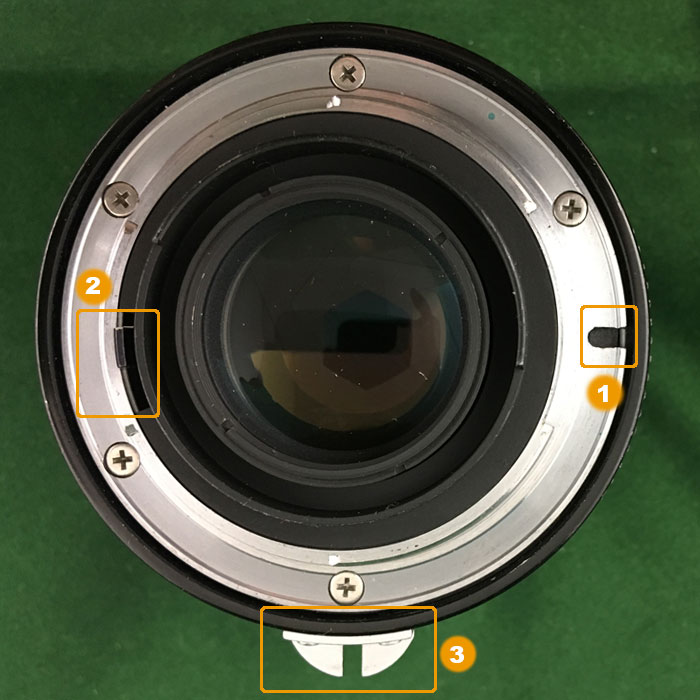
[2] Aperture release lever (closes down aperture as picture is taken).
[3] “Rabbit ears” for communicated selected aperture to camera body.
Note: the fact that the rabbit ears are at 6 o’clock in this (these) picture is coincidental, as the position of the rabbit ears change according to the selected aperture.
(Pictured: Nikkor (K-type) 50mm f/2)
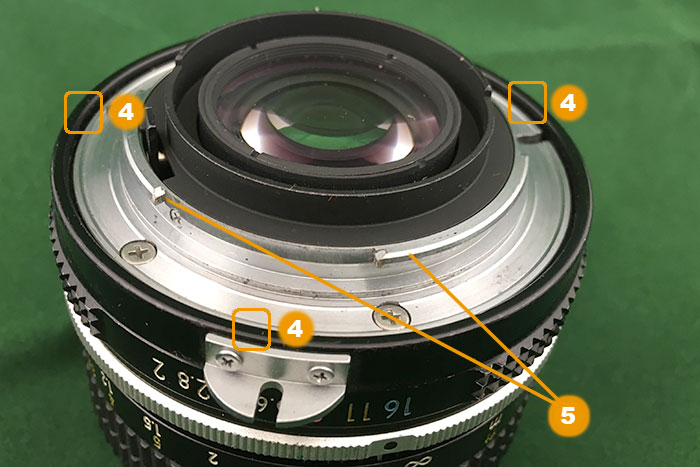
[5] Bayonet lugs (for mounting on body)
(Pictured: K-Nikkor 50mm f/2)
The purpose of this pin-and-rabbit ears interface is to allow a camera to correctly meter. Here’s how this would work:
- The user attaches the lens to the camera, making sure that the pin rests between the rabbit ears.
- The user would (once) cycle the lens from maximum to minimum aperture, thus informing the body of the range of apertures supported by the lens. The user would then commence shooting.
- In order for the user to always be able to see a bright picture in the viewfinder, the lens would always be held wide open (until a picture is taken).
- Assume the user has mounted a lens having a maximum aperture of f/2, and the user wants to shoot at f/5.6, and has set the lens aperture ring to that value.
- The camera now knows both these values, so when the user asks the camera to meter (i.e. calculate the amount of light available, the camera meters fully open (at f/2), and figures out the amount of light available would be sufficient for 1/500 second shutter speed.
- Knowing though, that the user wants to shoot at f/5.6, the optimal shutter speed is doubled (to 1/250), doubled again (to 1/125) and doubled once more (to 1/60). Depending on the model of the camera, this value would either be displayed to the user (for the user to set) or set automatically (aperture priority).
- Once the values have been set (either automatically or by the user), and the user proceeds to take the picture, the camera releases the lens’ stop down lever moments before taking the shot, thus ensuring proper exposure.
As such, this was a simple and elegant solution and fully satisfied both the needs of manual (but metered) shooting and would have allowed (semiautomatic) aperture priority shooting. As long as the user had remembered to cycle the aperture range after attaching the lens, the camera knew both the selected aperture as well as the existing range of apertures. Nevertheless, as it necessitated that the pin rests between the rabbit ears, and a lens had to be cycled after attachment, the system was somewhat fiddly. Therefore, Nikon revised the mount, introducing AI (automatic indexing) specification.
Stage 2: Ai and Ai-s lenses. (1977–>)
Automatic (aperture) indexing introduced a new method for communicating aperture information (selected and maximum) from lens to body. Instead of using the rabbit ears, the lens bottom (the aperture ring) would now have a ridge, that a feeler (protrusion) mounted on the body (around the lens mount) could read in order to ascertain the selected aperture, as well as another method for the camera to automatically ascertain the maximum aperture allowed by the lens. Therefore, no longer did the user have to cycle the lens through max and min aperture after mounting the lens, instead the camera would automatically read the relevant values during the mounting of the lens.
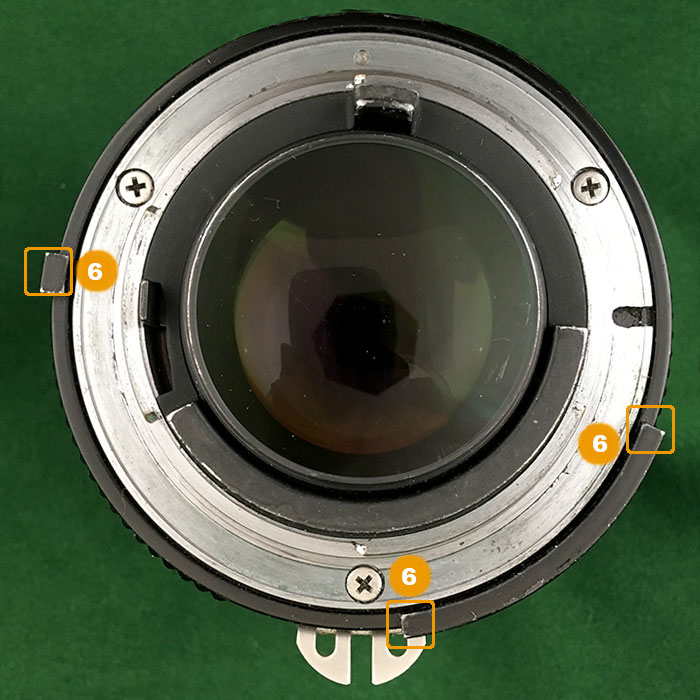
(Pictured: Ai Nikkor 50mm f/1.4)
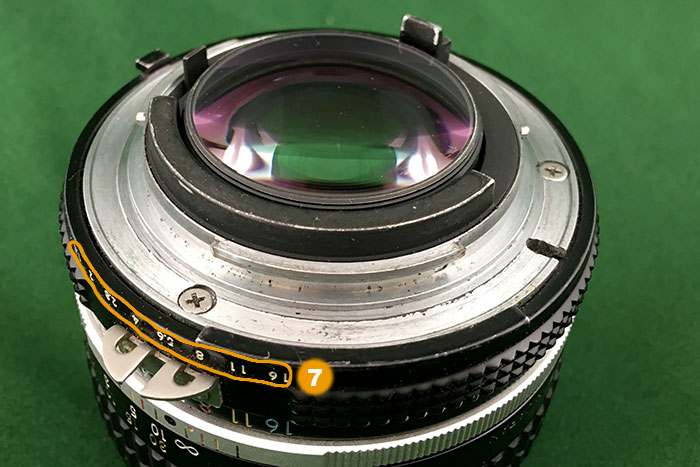
(Pictured: Ai Nikkor 50mm f/1.4)
Ai-s, on the other hand was a comparatively minor modification, but with sweeping consequences. While Ai had simplified the procedure for mounting a lens, avoiding a great many user errors (that you would not necessarily have noticed before your film came back from the lab incorrectly exposed), These cameras still acted only in manual or aperture priority mode. The ability for the camera to step-down a lens precisely (which both shutter priority and program priority shooting modes rely on) simply was not there, as Nikon had never before calibrated all its lenses, so that the stop down -lever’s motion on all lenses would exactly correspond to the aperture closing by an f-stop (or the desired amount). Implementing this addition was the central purpose of the introduction of Ai-s lenses. As this minor modification also often necessitated significant reworking of the lens’ innards, Nikon in many cases implemented other simultaneous changes (often the focus throw of Ai-s lenses would be significantly shorter than that of the same lens in Ai spec.), but in almost all cases the optical design of the lens stayed the same (notable exceptions: 28/2.8; 180/2.8; 35-70/3.5)
For a full list of changes, see: What did Nikon change going from Ai to Ai-s?

[9] This notch on the lens mount base shows that the lens is Ai-s.
[10] Some Ai-s lenses lost the rabbit ears, while others retained them.
(Pictured Series E Nikon 50mm f/1.8)
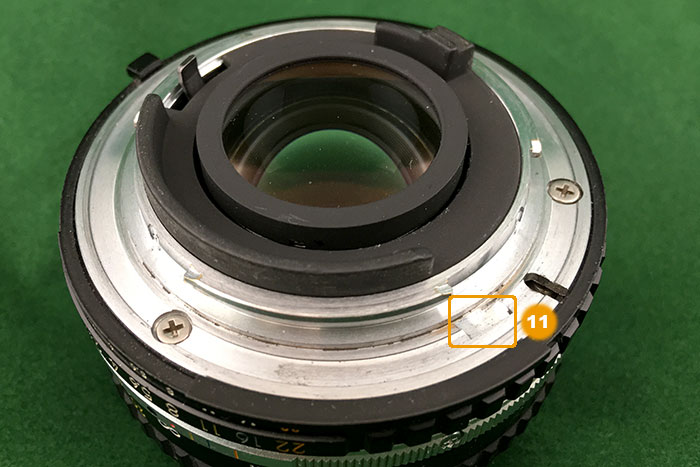
(Pictured Series E Nikon 50mm f/1.8)
Also, while often referred to simply as series E lenses, Nikons erstwhile budget lens range, are all in essence Ai-s lenses.
Interestingly, Nikon still produced (and sold) some Ai-s lenses (such as the venerable 50/1.2) until recently – a testament to the optical and handling quality of these lenses. Furthermore, as many were initially underwhelmed by the quality of Nikkor AF lenses, many Ai-s lenses continued being produced well into the AF age.
Stage 3: AF and AF-D lenses (1986-2003)
Many camera makers – Nikon included – had early on experimented with autofocus camera & lens combinations, leading to some – in retrospect – quite weird contraptions. The entry of autofocus (AF) into the mainstream of interchangeable lens cameras however only happened in the mid 80’s. While most major camera manufacturers introduced entirely new mounts to facilitate autofocus (basically betting the farm), Nikon (and Pentax) decided to facilitate autofocus within their existing lens mount, thereby allowing the back-catalog of lenses to be used on their new autofocus camera bodies (albeit, without autofocus).
The central method Nikon chose for facilitating autofocus was to have the camera body operate the lenses mechanically through what is commonly known as a “screw drive” – a slot screw head emplaced in the lens mount on the flange, connected to the lens’ focusing mechanism through a direct mechanical coupling, that would be turned by a small motor in the camera body. A further advantage of this was that lenses could be kept simple (indeed, almost all first-flight AF lenses were simple modifications of existing lens designs, albeit with AF and a novel housing), and a combination of one body and three lenses necessitated only one motor. At the same time, Nikon’s decision also had a number of drawbacks (none of which are directly related to the Nikon F-mount, and may therefore be addressed in a future article).
Besides this, Nikon also decided to implement an electronic interface, and equip their lenses with chips. This served two purposes: Firstly, for the electronic control of the aperture (thus making shutter priority and program auto handier) and secondly for identifying the lens, hence further aiding metering. In effect this also changed the way Nikon-shooters controlled lens aperture. Instead of using the lens aperture ring, Nikon users migrated to controlling aperture from the camera body. Nevertheless, the aperture ring remained fully functional, and could be used to override the camera settings at any time (with caveats, see more here).
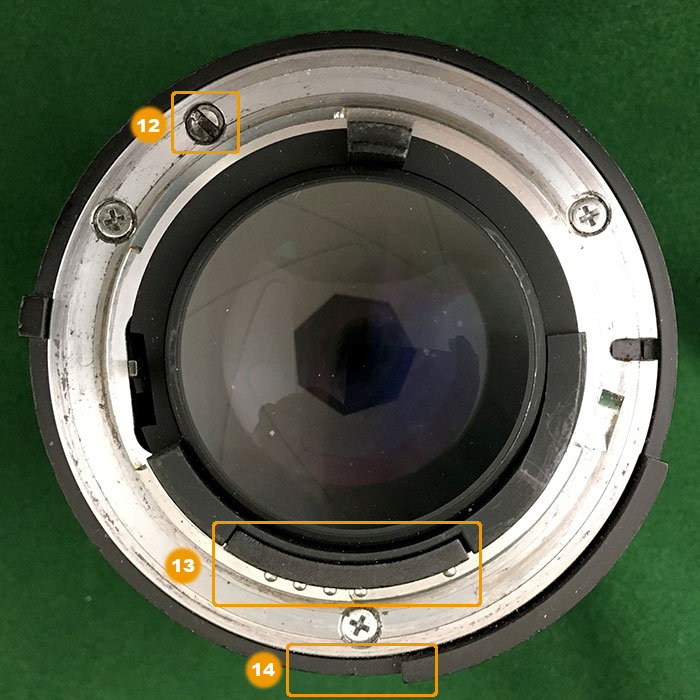
[13] Electronic contacts
[14] Rabbit ears finally gone
(Pictured: Nikkor AF-D 50mm f/1.4)
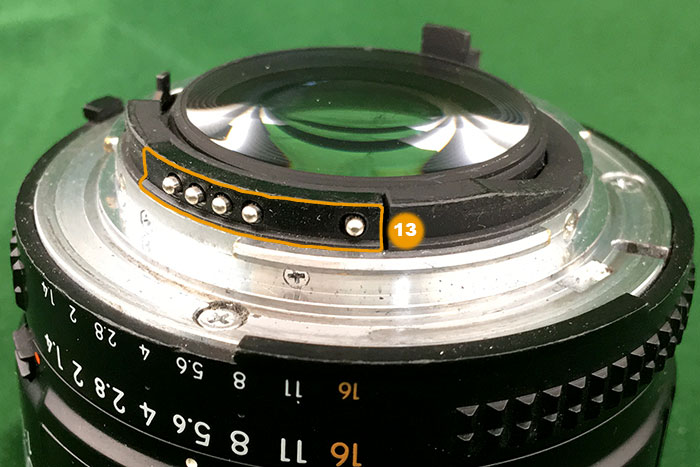
(Pictured: Nikkor AF-D 50mm f/1.4)
Interestingly, Nikon’s way of implementing this functionality not only allowed AF-bodies to use Ai and Ai-s lenses without issues, it also made AF lenses fully functional on Ai and Ai-s age bodies as well as usable on Pre-AI bodies. In effect, you can mount a Nikkor AF-D 85/1.8 lens from the 2010’s on a Nikon F body from 1959 (albeit only with stop-down metering, without modifying the lens). In practical terms, Nikkor AF lenses are AI-s lenses with added functionality.
Variants
AF-I
One central drawback of the “one motor to control them all” -approach Nikon had taken was that the motor in the camera body was used to drive a large range of lenses – both small and large. Light lenses could be driven with aggressive gearing (in the lens), while heavier (read: longer) lenses needed to be geared in such a way that the AF motor’s power was sufficient. In effect this led to that AF speed decreased with longer (necessitating longer focusing movement) and large-aperture lenses (heavier lenses, thus needing gearing that would maximise torque, at the expense of speed), making them seriously handicapped for – among others – sports photography. As a stopgap measure, Nikon introduced a number of AF-I lenses; lenses that did not rely on the screw drive, but instead had an internal motor (powered and operated through the electronic coupling). All these lenses were large aperture tele primes (300/2.8; 400/2.8; 500/4; 600/4). Furthermore, two teleconverters were also designed to be used with these lenses)
AF-I lenses can be identified by that they have the AF-I -moniker on the nameplate, by having ten electronic contacts, and by lacking the slot for the screw-drive. AF-I lenses also work on those Nikon bodies that lack the built-in motor for driving autofocus. Compatibility-wise, they are equal to non-G AF-S lenses.
AF-D
Starting in 1993, Nikon started updating their entire range of AF lenses to AF-D spec (Nikon’s nomenclature puts the “D” at the end of the lens designation, e.g. “AF 24/2.8 D”, but I refer to these as AF-D lenses). The “D” is short for “distance”, implying that the lens communicates distance information (at what distance is the lens focused) to the body, which is advantageous for metering, especially when using flash. In an absolute majority of cases, the supply of distance information is the only difference between otherwise seemingly identical lenses (in AF and AF-D spec), but in some, rare cases (e.g. AF-D 28/2.8; AF-D 35-105/3.5-4.5) the optical formula was also changed. Since 1993, all Nikkor lenses have had the ability to communicate distance information.
G
Common wisdom has it, “G” stands for “gelded”. In effect G-lenses have no aperture ring, and lens aperture can be controlled only electronically, by a (compatible) camera body. While G-type lenses have only lately become the norm (after the advent of AF-S lenses), they started appearing in 2000 and the first lenses without aperture ring were AF-D (not AF-S) lenses. Thus also, all G lenses (whether AF or AF-S) cannot be used on pre-AF bodies.
Stage 4 AF-S lenses (1996-> )
In this case, the “S” simply stands for “silent wave motor”, signifying a relatively silent autofocus motor within the lens (equivalent to Canon’s ‘Ultrasonic’). Not surprisingly, the first AF-S lenses replaced AF-I lenses, and it took a number of years before AF-S became mainstream in less extreme lenses. While the technological implementation of AF motor may vary among AF-S lenses, the important point is that AF-S lenses neither need nor use the AF motor built into the camera body.

NOTE the absence of slot-drive screw, AI ridges and AI-s notch. The only things that remain, are the bayonet lugs and the locking groove.
(Pictured Nikkor AF-S 50 mm f/1.4 G)
In contrast to earlier generation changes (such as from K to AI, and from AI-S to AF), all AF-S lenses are new designs (even those, which seemingly merely replaced existing AF-I lenses). While AF-S lenses are also mostly G-designs (lacking an aperture ring), this is not universal. Especially earlier pro-level AF-S zooms (e.g. 17-35/2.8; 28-70/2.8; 80-200/2.8) still sported an aperture ring and were in fact 100% Ai-s compatible.
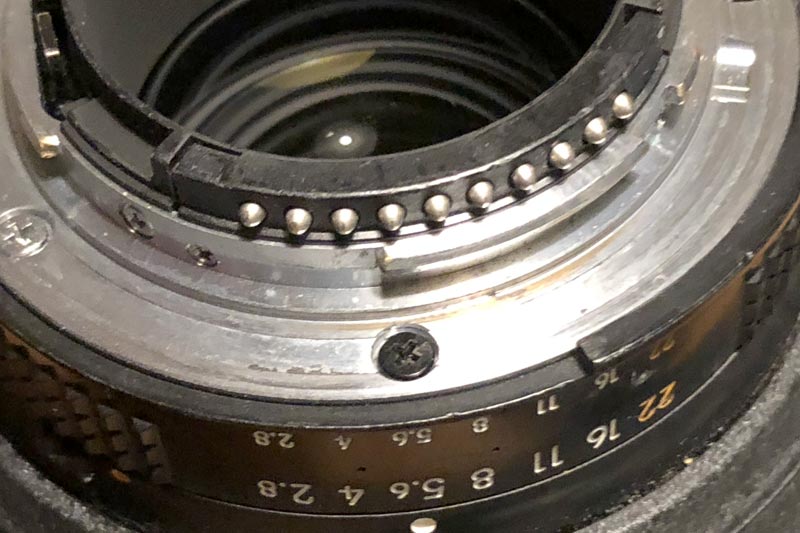
Interestingly, although technical developments usually tend to make trouble for old school habits, manual focusing of AF-S lenses is more pleasant than on AF/AF-D lenses (that due to their undampened focus rings offer very little in the way of ‘touch’).
Physically AF-S lenses are still F-mount lenses (you can physically fit a new AF-S lens on a 1959 Nikon F body), but as the control interfaces are mostly electronic, compatibility is limited. There is no screw drive, mostly (G and E lenses) no aperture ring. In short, compatibility of AF-S lenses is not straightforward (See below).
Variants:
G
(gelded), see above
E
(electronic aperture diaphragm, not to be confused by Series E subcategory of Ai-s lenses.)
Indicates that the aperture diaphragm is controlled (only) electronically, and the lens no longer has a manual lever for aperture control. E lenses therefore necessitate a body that can control the lens aperture electronically. In effect, all Nikon bodies introduced since 2007 can do that.
DX
DX in a Nikkor lens name signifies that the lens is designed for APS-C (crop factor) camera bodies. Typically, this means that such lenses will not cover the full-frame sensor (or will do so only with extreme vignetting). While you can mount these on full-frame bodies, this will (by default) activate the full-frame camera’s crop mode (in which it only uses the area of the sensor corresponding to that of an APS-C sensor). While overriding this default setting seldom is sensible, there are instances where additional usable pixels can be recovered this way.
(FX)
FX (in contrast to DX) is Nikon’s term for full-frame. FX does not appear in lens names (if it is not DX, it is FX), but does appear in the dames of full-frame dSLR bodies.
AF-P
AF-P lenses are further developments on AF-S lenses which use a stepper motor for focusing. AF-P lenses are also automatically equipped with an electronic aperture diaphragm (see above). This has advantages, especially in live view (and, thereby, in videography), but also means that the lens’ usability depends entirely on a compatible body. While AF-P lenses have a manual focus ring, this ring does in no way control the lens. Instead, manually focusing an AF-P lens (turning the focus ring) just sends a command to the body (which in turn commands the lens stepper motor). AF-P lenses thus are basically useless on anything but the newest Nikon bodies (about 2013 and later).
Luckily, AF-P lenses are generally not intended to supplant AF-S lenses entirely. Instead, they are mostly intended as budget options for a specific type of consumer.
Compatibility
The central question, especially considering all the above mentioned limitations on compatibility, is whether seeing the entire 60-year journey of the Nikon F mount and its variants as the history of one mount, or whether we should in fact see the Nikon F mount as a group of physically similar mounts, which nevertheless are substantially different and mutually incompatible.
Firstly, over the years there have been several (typically higher-end) camera models which have spanned the divides between stages. Camera bodies such as for example the Nikon F4 (supporting everything from pre-Ai to AF), FE and FM (Ditto), or D700 (supporting everything from Ai to AF-S), that have shown that Nikon has valued backwards compatibility more than (almost) any other camera maker.
Secondly, there is one camera model manufactured by Nikon which accepts and utilizes every single lens (barring a select few that simply won’t fit) from 1959 to the newest AF-S and AF-P lenses: the Nikon Df.
While the mere existence of the Nikon Df conclusively shows that the Nikon F mount, can and should be seen as one mount (albeit with variants), that does not change the fact that serious incompatibilities may arise. While this article should give you descriptions of the reasons for such incompatibilities, you may want a simpler (“can I use lens X on body Y) answer. Should that be the case, either ask in the comments, or look at the links at the bottom of this article.
Modifications
There are two types of modifications worth mentioning: Firstly, the modification of pre-AI (F, C and K) lenses to AI spec, and secondly, the more unusual modification, intended to make lenses work on pre-AI age cameras.
Modification to AI spec.
There are essentially two types of such modifications: Those done by Nikon (or one of its service companies) using factory-supplied parts, and those done privately with different degrees of proficiency. Both kinds are often (e.g. on eBay) referred to as ‘Ai’d’ lenses, and prospective buyers would do well to pay attention to the pedigree of the conversion.
Official Ai’d
Nikon knew that they had a dedicated and large user base with money invested in F, C and K lenses, who might be less enthusiastic about buying a new camera if they’d have to buy new lenses. Therefore, Nikon (and its network of service companies) offered to modify existing pre-AI lenses. While (to my knowledge) Nikon no longer supplies these conversion sets, many long-running service companies still have inventory of some of these conversion sets, and can thus easily convert old pre-AI lenses into Ai’d lenses.

Third-party Ai’d
Given that the necessary conversion usually is doable using precision tools, glue and paper to those so inclined many people from all walks of life have made their own conversions. While some of these third-party conversions are virtually indistinguishable from those made using Nikon’s conversion sets, there are also conversions which have been made by people lacking the necessary tools and expertise. In some cases, even kludge conversions may work flawlessly, but can also lead to that the lens meters incorrectly. Buyers beware.
Modification to pre-AI
While obviously a lot less usual, some newer lenses (but not G-lenses, obviously) have been modified to work on pre-AI bodies. In practice, this means adding the rabbit ears to such lenses which have not had them originally. While this operation was never officially supported by Nikon (thus, no official pre-AI modifications exist), the operation in itself is relatively easy and (when done by a proficient mechanic) reliable. “But why?”, you may ask. In essence such a modification allows you to mount any Nikon lens sporting an aperture ring on a Nikon F camera body (and other pre-AI bodies), while also supporting that camera’s ability to meter.
Identifying Your Nikkor Lens
(Section is slightly unfinished, but may be helpful and has thus been published.)
Considering that lenses have been modified forward (Ai’d) and backward, Identifying a Nikkor lens with absolute surety cannot solely rely on characteristics of the lens mount. That said, the table below might help.
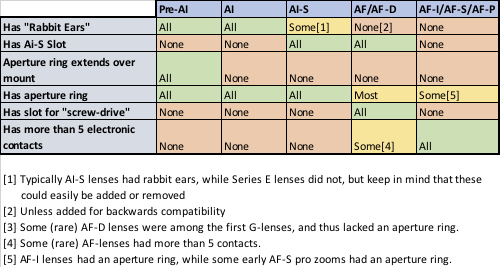
Further questions?
Q: Okay, my lens is Pre-AI, but is it an F, a C or a K-lens?
A: K-lenses typically had a rubberised focusing ring, while F- and C-lenses had a scalloped or milled (metal) focusing ring. C-lenses differ from F-lenses in that they are coated and typically have a letter “C” in their lens name/designator.
Q: My lens has a screw drive slot, but is it an AF- lens or an AF-D lens? And does it really matter?
A: AF-D lenses always have a “D” appended to their name. In some rare cases (see above) the optical recipe was modified from AF to AF-D and the distance information might help with metering, but otherwise, there’s little difference.
Q: This seems confusing. Is there really no way to know for sure what type my Nikon lens is?
A: It is. If you have your lens’ serial number, and are prepared to tackle a spreadsheet with ≈ 750 lines, you can head over to Roland’s Nikon Pages (see links below) to find out what your lens was when it left the factory.
Further reading (links open in new window):
Roland’s Nikon pages – Nikon Lenses
Ken Rockwell – Nikon compatibility